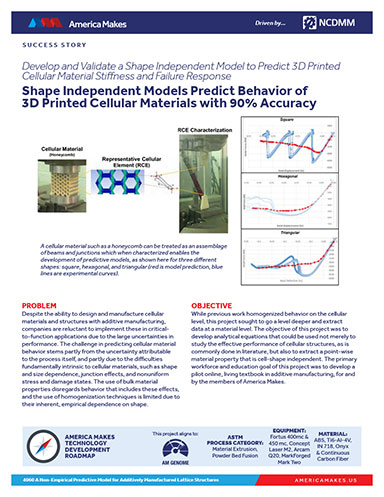Predict 3D Printed Cellular Material Stiffness and Failure Response
Shape Independent Models Predict Behavior of 3D Printed Cellular Materials with 90% Accuracy.

September 12, 2019
PROBLEM
Despite the ability to design and manufacture cellular materials and structures with additive manufacturing, companies are reluctant to implement these in criticalto- function applications due to the large uncertainties in performance.
The challenge in predicting cellular material behavior stems partly from the uncertainty attributable to the process itself, and partly due to the difficulties fundamentally intrinsic to cellular materials, such as shape and size dependence, junction effects, and nonuniform stress and damage states.
The use of bulk material properties disregards behavior that includes these effects, and the use of homogenization techniques is limited due to their inherent, empirical dependence on shape.
OBJECTIVE
While previous work homogenized behavior on the cellular level, this project sought to go a level deeper and extract data at a material level. The objective of this project was to develop analytical equations that could be used not merely to study the effective performance of cellular structures, as is commonly done in literature, but also to extract a point-wise material property that is cell-shape independent.
The primary workforce and education goal of this project was to develop a pilot online, living textbook in additive manufacturing, for and by the members of America Makes.
Fill out the information below to download the resource.
Latest News





